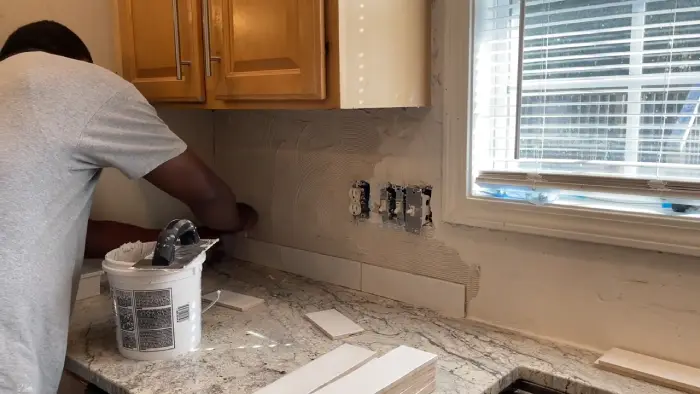Last Updated on July 30, 2023
Tiling can unleash your inner interior designer and make any space look amazing. But what if you have some broken drywall? Can it still work for tiling projects? Tiling over torn walls is totally possible, but just don’t forget the first step: patch up that wall befoasbestosre getting started with tile layers.
If your drywall needs a tile makeover, you’ll want to start by prepping the surface. Then get to laying down some mastic or mortar as the foundation of beautiful tiles. Seal them off for longevity’s sake, and then add grout as the finishing touch.
Without the proper preparation work, you could find yourself inhaling gypsum powder, and dealing with pesky allergies & respiratory issues, all while wrestling cracks, divots, and holes that seem to pop up everywhere. Here we’ll cover how to tile properly, so all those issues won’t come up later.
How Can You Tile Over Torn Drywall?
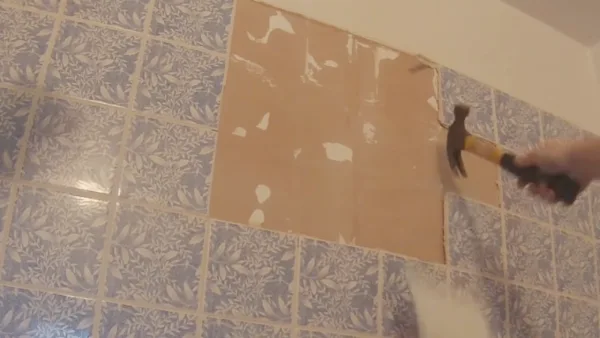
Tiling over drywall helps update the look of your home and add value. Properly tiling over torn drywall requires following 4 steps in order and taking extra care at each stage of the process.
Step 1: Prepare the Surface:
Prepare the surface before attempting to tile over torn drywall paper. Take off any old wallpaper, paint, or anything else that might be on it.
Use a joint compound or spackle to repair any large holes or cracks on the wall, and then sand it evenly with sandpaper until it’s smooth throughout. Then, use a sponge and some degreasing soap to wash off any dirt or dust from the wall and let it air-dry before continuing with the next step.
Step 2: Lay Down a Layer of Mortar:
Before you start tiling, you need to apply mortar. This will stick the tiles to the wall and ensure your project lasts a long time. Make sure you follow the directions for mixing the mortar carefully, depending on which type it is. Each one has different requirements for consistency and how much water needs to be added.
Using a trowel, start applying thin layers of mortar onto your wall until all areas have been covered evenly. Then, leave this layer to set according to manufacturer instructions before proceeding with installing tiles onto it.

When putting in ceramic tiles, it’s best to use premixed tile mastic (glue) instead of just mortar. It will make sure that the tiles stay on better with the glue.
Step 3: Install New Tile on the Wall:
Put spacers in each corner of your tile project to keep everything even. Leave them in until after you grout. Take the tile and press it down firmly for the best stick.
If some edges don’t fit together, use a wet saw to cut the tiles into the right shape. Clean off any extra glue with a damp sponge, so nothing is left behind when you’re done.
Step 4: Seal and Grout The Tile:
Once you have installed all your tiles onto the wall, seal them according to what type they are using, either impregnating sealer or wax sealant. Mix up grout following manufacturer instructions.
If needed, add more water and make sure to get the right consistency. Otherwise, drying won’t create the right bond between tile and drywall.
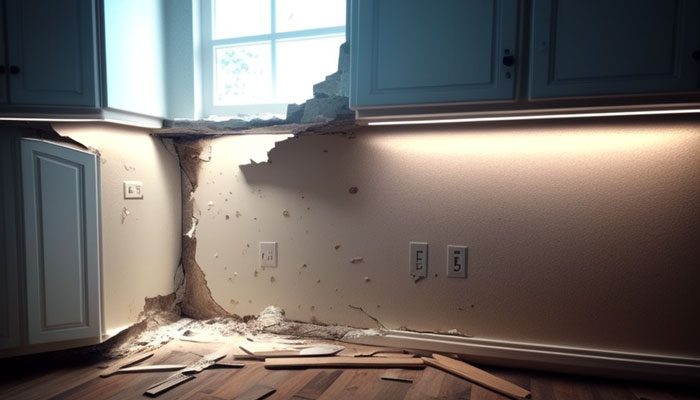
Apply grout onto gaps between each tile carefully, smoothing out any bumps to ensure an even finish. Let dry completely, then remove spacers inside corners. Wipe off excess grout with a damp cloth. After all these steps have been completed, you will now have successfully tiled over drywall with torn paper.
What is the Benefit of Tile Mastic Adhesive Over Thinset Mortar for Tile Installation?
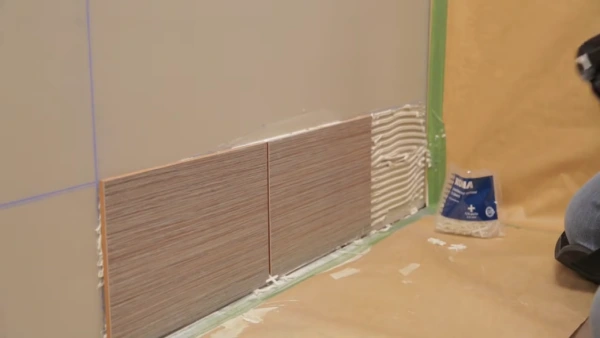
Installing tile can be a tricky job, and choosing the right tile adhesive is important to ensure a successful result. Tile mastic adhesive provides significant benefits over thinset mortar during tile installation, making it an essential choice for many projects.
1. User-friendly:
Premixed mastic adhesive is much easier to use than thinset mortar when tiling projects. It has a smoother consistency that makes it simple to spread evenly onto the surface, creating a strong bond for the tiles without needing complex techniques or tools.
It also grabs onto tiles quickly, so you don’t have to wait long before joining each piece together. Unlike thinset mortar, waterproof membrane mastic doesn’t need extra water or adjustments as you apply it. Simply spread it on and stick down your tiles, and you’re done.
2. Right Consistency:
The right consistency of premixed mastic adhesive makes it superior to thinset mortar in many ways. Its thick, pasty texture ensures that each tile is securely held in place with no chance of slipping or sliding out of place.
Thinset mortar can be tricky to use because you have to ensure it’s the right thickness. But premixed mastic is already the right thickness, and you don’t have to do anything else.
3. Easy to Clean:
Compared to thinset mortar, premixed mastic adhesives offer much easier clean up after tile installation has been completed. Since you don’t need any water during the application process, there’s no need for messy buckets or damp sponges afterward either.
All you need is a dry rag and some elbow grease to get rid of any excess material from your surfaces. Because of its sticky nature, any bits that do remain can usually be peeled away easily without leaving behind any difficult-to-remove residue like might happen with thinset mortar.
Working with conventional mortars usually requires more effort since they tend to harden quickly and become difficult to remove from surface areas once they have dried.
What Happens If You Don’t Repair the Drywall Before Tiling
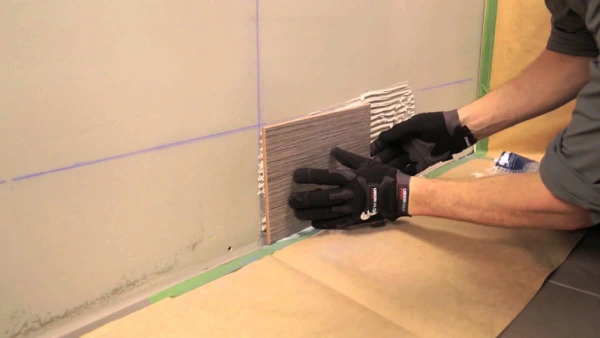
Tiling over damaged drywall can result in serious issues if the underlying damage is not properly repaired beforehand. You need to assess and repair any existing damage before tiling, as this can help ensure better results and reduce potential health risks, structural damages, and financial implications.
1. Potential Health Risks:
When the drywall is not repaired before tiling, it leaves users exposed to gypsum powder or airborne particles released from the wall during tiling work. This exposure can cause respiratory problems and other related allergic reactions.
Tiles and drywall (sheetrock) may also contain asbestos that needs to be handled with extreme care when working on a potentially damaged wall. Therefore, it is essential to mend any cracks and divots before starting the tiling process in order to protect everyone’s health.
2. Structural Damage to the Wall and Tiles:
If drywall damages are not repaired prior to tiling, it can cause further structural damage down the line. This includes cracks appearing along the edges of tiles or any areas that weren’t filled or smoothed out properly before application.
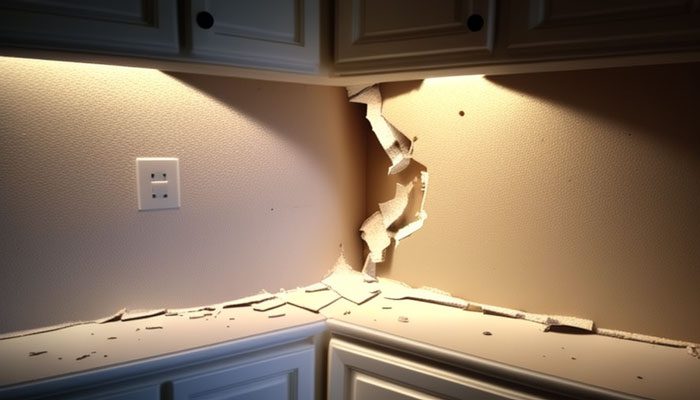
Loose tiles may become unhinged over time due to a lack of good adhesion on rough patches of drywall that have yet to be repaired. As a result, these issues could require costly repairs for homeowners at some point in the future if proper preparations weren’t made beforehand.
3. Issues with Adhesive and Grout Applications:
Applying adhesive directly onto an uneven surface can be difficult since it will likely not adhere properly until all underlying damages have been addressed first. An uneven surface affects how evenly grout spreads across tiles as well as how strong their hold will be once applied.
There may be difficulty applying grout correctly onto rough patches due to its poor adhesion capabilities. This could even impact how well water-resistant your tile job turns out in the end.
4. Financial Implications of Neglecting Repairs Before Tiling:
Neglecting necessary repairs on drywall before starting a tile job could lead to much higher overall costs down the line. It increases labor hours needed for additional repair work and replacing broken tiles or damaged walls within time frames.
Can You Skim Coat Over Torn Drywall?
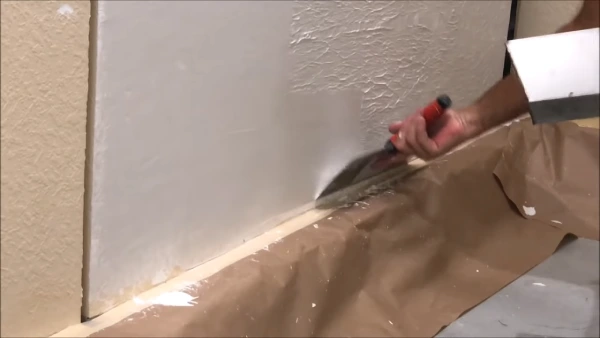
Yes, you can apply a skim coat of drywall compound to repair torn drywall when gouges from tearing off the drywall’s outer paper. It is essential to completely repair and level out the area before retexturing.
Sand the area before applying the first coat and again in between each additional coat of compound. If you are still seeing puckering or raw paper behind after sanding, add another layer of compound until the desired finish is reached. It may be necessary to repeat this process several times for the best results.
Should You Remove Water Damaged Drywall?
Remove water damaged drywall as the water can cause softening, bubbling, and discoloration of the drywall as well as peeling paint and other signs of damage. The water could also have seeped into other areas of the wall, causing unseen damage, which could lead to further complications in the future.
How Do You Fill the Gap Between Drywall and Tile?
The best way to fill gaps between drywall and tile is to use mortar or premixed tile mastic adhesive. For larger gaps, you may need to use a backer rod and caulk combination in order to get a good seal and ensure that no moisture will enter through the cracks.
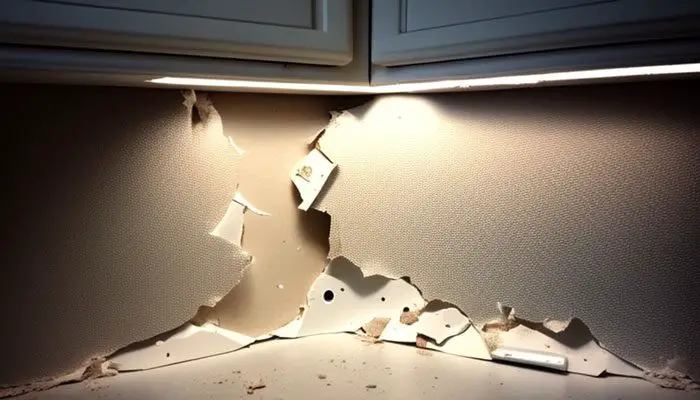
Can You Put Backsplash over Torn Drywall?
Yes, you can put backsplash tiles over torn drywall. It is important to incorporate a silicone edge in order to keep the water out of the joint between the wall and the tile. For installation, you should use tile mastic rather than mortar, as mortar doesn’t provide enough flexibility for movement and can crack the tiles.
Do You Have to Use a Cement Board above Torn Drywall?
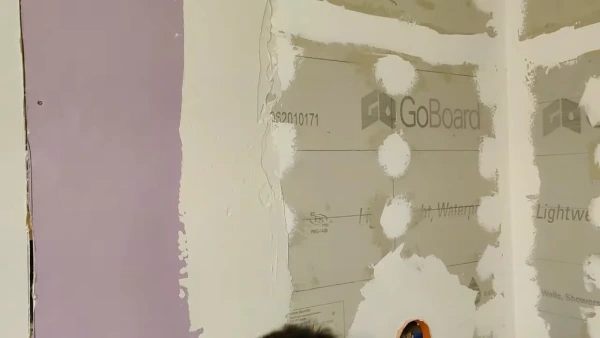
No, you don’t need a cement board above torn drywall when installing a kitchen backsplash. It is still advisable if you want a very low-stress installation that will hold up well in a wet area.
If you do choose to use cement board, make sure to fasten it with rust-resistant drywall screws and always put heavy plastic sheeting underneath it first as a result.
Repair Torn Drywall with Tiling for a Sleek, Modern Look
Tiling over torn drywall can be a great way to repair any damage that may have been done to your walls. Not only does it look better than torn-up walls, but it also provides extra protection against moisture damage.
Before beginning any tiling project, ensure that you have properly repaired the drywall and applied either tile mastic or thinset mortar in order to ensure that your tiles will stay secure and last longer. With a little patience, you’re on track toward achieving that sleek, modern look you’ve been waiting for on your wall.
